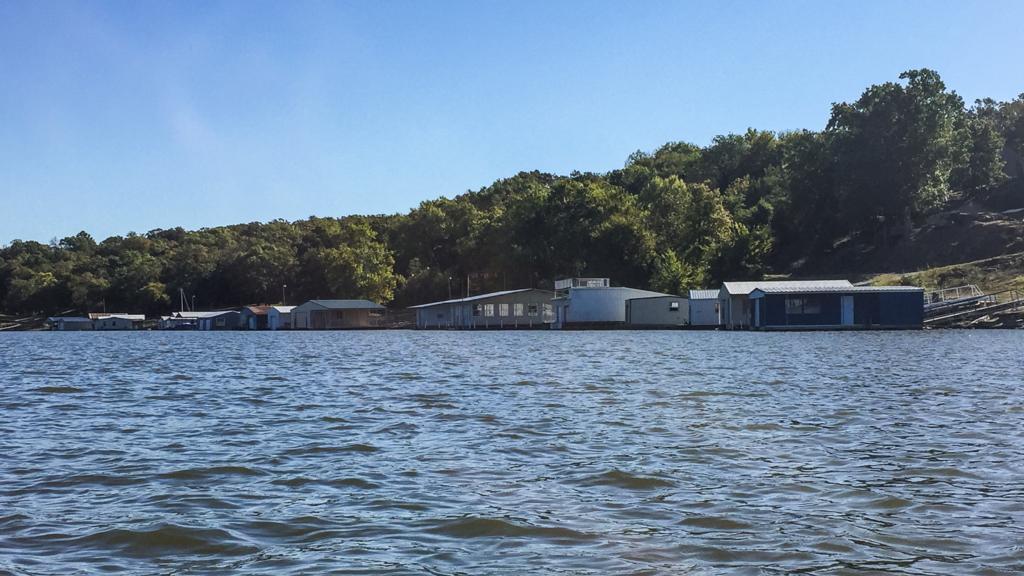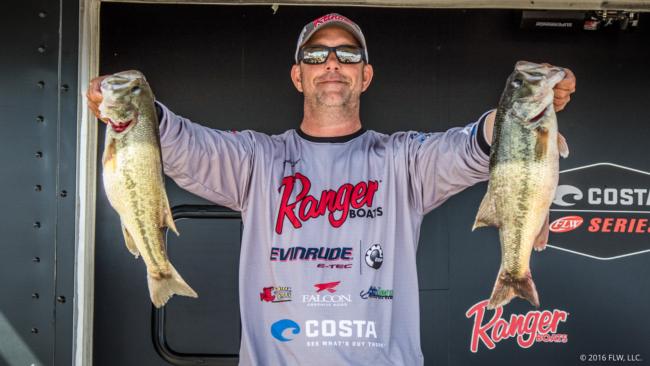Summer or Fall at Fort Gibson?
Southwestern Division finale falls smack dab on the late-summer transition

When the Costa FLW Series Southwestern Division culminates this week at Fort Gibson Lake, summer patterns will likely linger, but fish won’t be far from the fall feeding mode.
“It’s gotten a lot cooler there than it has at my home in Brookeland, Texas, so they might be starting into that fall deal, but I still think it’s going to be a little bit of a transition,” says Walmart FLW Tour pro Chris McCall, who currently ranks second in divisional points.
The tournament, presented by Lowrance, kicks off on Thursday out of Taylor’s Ferry North in Wagoner, Okla. In addition to the Strike King Angler of the Year race for the Southwestern Division, qualification into the 2016 Costa FLW Series Championship will be determined, with slots reserved for the top 40 boaters and co-anglers in the season standings.
About the fishery
A modest body, Fort Gibson covers about 20,000 surface acres. It’s an impoundment of the Grand (Neosho) River situated about five miles northwest of Fort Gibson, Okla., on the eastern end of the state, and about 7.7 miles above the confluence of the Grand and Arkansas rivers. The lake is impounded by Fort Gibson Dam, which is a hydroelectric/flood control structure that was completed in 1949 and is operated by the U.S. Army Corps of Engineers.
While Fort Gibson has spots and some good smallmouths, largemouths will probably dominate this event.
Currently eighth in points is Tour pro Zack Birge, who lives two hours southwest in Blanchard, Okla. Birge calls Fort Gibson his home waters. Considering the season, as well as the lake’s generally temperamental nature, he advises treating this fishery with the flexibility one might employ on a tidal river.
“Fort Gibson is the type of place that can change by the hour. It almost changes by the minute,” Birge says. “They fluctuate that lake so much with water moving down the Grand River. Guys will have a good practice and then go out there the next day and it will be different, and they won’t adjust to it.”
Factors in play
Water level: At this writing, Fort Gibson’s water level is just slightly higher than its normal level, which is 554 feet. McCall says that higher water would help even the playing field.
“If it’s high, the water willows or buck brush come into play, and that helps all of us from out of town. Otherwise the locals have a distinct advantage because a lot of those guys put out a ton of brush piles,” McCall says. “I’d like to see it remain high because that takes away a little bit of that local advantage. But who knows. If the water comes up and it stays clean, those offshore spots might still be the better places.”
Current: Moving water positions fish, but turbidity remains a potential downside. If the current’s trucking, McCall says he’ll spend most of his time in the river targeting the usual current breaks that provide downstream ambush spots.
Air temperature: Tournament week will most likely remain mild, but should a significant temperature drop occur, we could see acceleration toward fall patterns.
Pressure: As McCall notes, too much sore-lipping can hurt a lake that already fishes small.
“This lake has one of the state’s best 4- to 5-pound fish populations, but practice can significantly impact Fort Gibson,” he explains. “We’ll probably have about 115 boats, and they’ll pick it over pretty good.”
The playbook
McCall points out that the recent explosion of articulated (“wobble head”) jigs like the Gene Larew Biffle HardHead designed by local legend Tommy Biffle now keeps a lot of Fort Gibson anglers off the bank.
“I think it will be a typical Oklahoma tournament – moving around a lot, junk-fishing, throwing a lot of moving baits,” McCall says. “But there is a lot more offshore fishing going on here than there used to be.”
Offshore anglers targeting submerged building foundations and natural rock will also throw deep-diving crankbaits, big worms, football heads and the occasional Carolina rig.
Other promising options include square-bills, spinnerbaits and walking topwaters up the river; flipping and pitching main-lake bushes; and throwing topwaters at shallow targets.
“You want to fish topwaters on shallow, flat points with baseball-sized rock,” Birge says. “There should be a lot of baitfish up there, so the fish will be up there feeding in the mornings. Any walking or popping topwater will work, but they really like the Whopper Plopper on Fort Gibson.”
“The bait selection will run the gamut,” McCall adds. “If it cools down enough, there’ll probably be some fish caught on an Alabama Rig.”
Risk/reward
Fort Gibson might be small, but its size allows anglers a diverse game plan. You’re not necessarily locked into one area, so a change of pace or scenery is never out of reach.
“You can fish down lake all day and then say, ‘Let’s run up the river,’ and you can be up there in 15 minutes,” Birge says. “If I have 12 to 13 pounds down lake and I don’t think I’ll get the bites I need, I won’t hesitate to run up the river.”
Notwithstanding this option, Birge notes that several main-lake tributaries such as Spring Creek and Flat Rock offer lots of fishable water. Some bristle with stumps and timber, so don’t rush.
Birge’s advice: “Don’t hug your turns too closely. Fort Gibson is full of flats. Every point seems to go out forever, so don’t hug the banks. And if you’re unfamiliar with the lake, ease your way into the shallow areas.”
The AOY race
Veteran Texan Russell Cecil leads the Southwestern Division AOY race with 485 points. He enjoys a slim two-point margin over fellow Texan Chris McCall.
The AOY title is determined by total points earned over the three-tournament divisional season. The winner earns the $2,000 Strike King AOY package, which includes deposits for the 2017 season. The Co-angler of the Year prize package worth $800 includes 2017 deposits as well.
The current top-10 standings in the AOY race:
1. Russell Cecil – Willis, Texas – 485 points
2. Chris McCall – Brookeland, Texas – 483
3. Jeffrey Randolph – Huntsville, Texas – 469
4. Kyle Cortiana – Broken Arrow, Okla. – 465
5. Jesse Wolfe – Nelson, Wis. – 464
6. Nick LeBrun – Bossier City, La. – 464
7. Jeff Dobson – Ponca City, Okla. – 452
8. Zack Birge – Blanchard, Okla. – 450
9. Jeff Sprague – Point, Texas – 447
10. Tommy Martin – Hemphill, Texas – 442
Tournament Details
Format: All boaters and co-anglers will compete for two days. The top 10 boaters and co-anglers based on cumulative weight after two days of competition will advance to the third and final round, with the winner determined by the heaviest cumulative three-day weight.
Takeoff Time: 7:30 a.m. CT
Takeoff Location: Taylor’s Ferry North, Dock Road, Wagoner, OK
Weigh-In Time: 3:30 p.m. CT on days one and two; 4:30 p.m. CT on day three
Weigh-In Location: Taylor’s Ferry North on days one and two; Walmart, 410 S Dewey Ave., Wagoner, OK on day three
